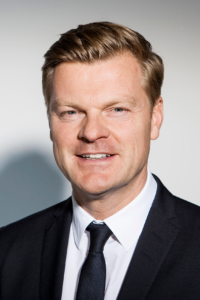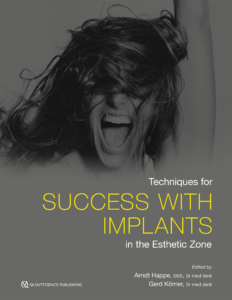They say a smile is worth a hundred watts, a thousand words, and a million dollars. What is the perfect smile worth to your patients? According to Arndt Happe, DDS, Dr med dent, and Gerd Körner, Dr med dent, successful implant therapy in the esthetic zone is priceless.

While the implants at the maxillary left lateral incisor and canine sites have been functioning for several years, the result is not a success for the patient because the esthetics are so poor.
While there are many books on the importance of implant stability, these two implantologists found that few resources also took into account the importance of esthetics. They teamed up with a group of eight contributors to write a book specifically on implant therapy in the esthetic zone: Techniques for Success with Implants in the Esthetic Zone. Despite similar endeavors by other specialists in the meantime, the team knew they had something of value to add to the existing literature: a book on implant therapy in the esthetic zone that also incorporates related areas of dentistry, including periodontology, restorative dentistry, orthodontics, function, and dental technology.
“The so-called ‘esthetic zone’ is a very individual region of interest.”
Successful esthetic results require clinicians to consider these other specialties. Still, the esthetic zone is a fairly limited region, which begs the question: Why would a whole book need to be written about essentially four teeth? A misconception that the anterior region is a “simple” location is all too prevalent among clinicians.
“The book is not necessarily about four front teeth,” Dr Happe explains. “The so-called ‘esthetic zone’ is a very individual region of interest. Some people only show the incisal edge when smiling, while others show the first molar including the facial soft tissue. Regardless of the smile line, many people raise their lip with a finger to assess the result of an implant treatment that is both expensive and exciting. They want to see what the result looks like and take the esthetic outcome as a surrogate parameter in order to evaluate the dentist’s work.”

A patient with a high smile line exposes the esthetically and functionally inadequate peri-implant soft tissue situation in the region of the maxillary central incisors.
This is where smile line dynamics come into play. Twenty percent of people have a low smile line, which reveals less than 75% of the height of the maxillary anterior teeth; 70% have a medium smile line, which reveals 75% to 100% of the maxillary anterior tooth height, plus papillary apices; and—more common among women—10% have a high smile line, which reveals gingiva in addition to the entire maxillary anterior tooth height. Therefore, each patient’s esthetic zone needs are unique.
Yet, compared to full-mouth implant-supported reconstructions, the anterior region seems like it should be a cakewalk. This allure is due to its easy access, often with limited hard and soft tissue defects and the high healing potential of young patients. However, behind this appeal lies the reality that two of these three elements also double as hindrances. When tissue defects do occur in the esthetic zone, their high visibility requires stringent accuracy and microsurgical attention to detail. In addition, treating younger patients puts more pressure on clinicians because the esthetics and functionality of those restorations require longer posttreatment maintenance than for older patients.

(a) Unlike natural teeth, implants have no attachment: The collagen fibers of the connective tissue do not integrate with the implant, and no supracrestal fibrous tissue exists. Because the implant has no periodontal space, its vessels are absent, and the peri-implant tissue is poorer in blood vessels. Then there is the added influence of the microgap. All of these circumstances make it difficult to reconstruct soft tissues and papillae around implants. (b) Comparison of structures around implants with non-platform-switched connection (left) and platform switching (right).
“Every region in the mouth has specific challenges in implant dentistry,” Dr Happe says. “That is due to anatomical structure, accessibility, and biology. Some people think: Simply extract a single-rooted tooth and place a root-shaped implant in order to preserve the tissues, and—done. But that is a flawed approach. The biology in that area is far more complex. As a clinician you need to have an understanding of the biology around teeth and implants and the changes that may be expected after tooth extraction.”
Because tooth loss and tissue loss occur together, achieving favorable results in the esthetic zone is one of the biggest challenges in implantology. A systematized esthetic assessment has been traditionally left out of dental education, and most studies do not clearly define measurement parameters. Emphasis used to be on survival rate—purely a measure of function, which is frustrating when today’s patients are primarily concerned with esthetics.
Achieving favorable results in the esthetic zone is one of the biggest challenges in implantology.
Over time, other evaluation methods used osseointegration success as an indicator of implant success. By the early 2000s, three new assessments had been developed: (1) white esthetic score, (2) pink esthetic score, and (3) a combination of the two. White esthetic score uses nine parameters to evaluate crown and soft tissue, while pink esthetic score measures only peri-implant soft tissue using seven parameters. The combination assessment uses five parameters each to measure crown and soft tissue success. However, successful esthetic treatment and assessment is not always as straightforward as it sounds.
“Many patients come for single-tooth replacement but don’t know that they in fact carry multiple dental risks and issues and need a more complex treatment,” Dr Happe recalls. “That requires proper evaluation, risk assessment, and a good communication strategy. In many implant cases we have to deal with a deficient site. We need predictable techniques in order to regenerate hard and soft tissues.”
He recommends the following seven elements of quantifiable esthetic criteria: (1) midline, (2) relationship of occlusal plane to bipupillary line, (3) position of incisal edges of central incisors in maxilla, (4) proportions of maxillary anterior teeth, (5) relationship of incisal edges of maxillary anterior teeth to lips, (6) buccal corridor, and (7) relationship of maxillary anterior dentition to mandibular anterior dentition.

Digital photographs can greatly simplify communication with patients. Given the right setup, professional patient portraits can be taken with relatively minimal investment.
Dr Happe also advocates for methods of treatment planning and esthetic analysis that involve casts, models, intraoral and extraoral photos, or patients directly. Casts especially help effectively assess spatial conditions and occlusal relationships and can facilitate communication with patients. A general rule of thumb is to create anatomical casts to establish the preoperative situation, which can then be reused for planning purposes.

Viewing the photographs together with the patient rather than chairside is a more comfortable experience for the patient.
“Surgically meticulously reconstructed tissues may be jeopardized with poorly carried out restorative treatment,” Dr Happe stresses. “That is why we have covered this topic very extensively in our book. I think the book we put together is quite unique and covers all the important aspects for implants in the esthetic zone. I hope our colleagues enjoy it and feel inspired to put a perfect smile on their patients’ faces!”
 Arndt Happe, DDS, Dr med dent, studied dentistry at University of Münster and completed his specialist training with Prof Dr K. Khoury. In 1999, Dr Happe successfully completed advanced training to become an oral surgeon. He then acquired an implantology specialty in 2000 and a periodontology specialty in 2004. In 2013, Dr Happe gained his postdoctoral lecturing qualification and began a teaching position in the Department of Maxillofacial and Plastic Surgery, Oral Surgery, and Implantology at University Hospital Cologne. Dr Happe is a sought-after speaker at national and international conferences as well as the author and coauthor of several scientific articles and book chapters. He is an active member of the European Academy of Esthetic Dentistry and a member of numerous other scientific associations. Dr Happe maintains a private practice in Münster.
Arndt Happe, DDS, Dr med dent, studied dentistry at University of Münster and completed his specialist training with Prof Dr K. Khoury. In 1999, Dr Happe successfully completed advanced training to become an oral surgeon. He then acquired an implantology specialty in 2000 and a periodontology specialty in 2004. In 2013, Dr Happe gained his postdoctoral lecturing qualification and began a teaching position in the Department of Maxillofacial and Plastic Surgery, Oral Surgery, and Implantology at University Hospital Cologne. Dr Happe is a sought-after speaker at national and international conferences as well as the author and coauthor of several scientific articles and book chapters. He is an active member of the European Academy of Esthetic Dentistry and a member of numerous other scientific associations. Dr Happe maintains a private practice in Münster.
 Gerd Körner, Dr med dent, studied dentistry at University of Münster and was involved with the department of periodontology from 1975 to 1979. After his residency in independent practice, he set up his own practice in Bielefeld, Germany, in 1981 and gained a periodontology specialization in 1983. Dr Körner expanded his skill set by integrating implantology, and in recent years, he has increasingly focused on finding solutions to esthetically challenging situations, even in patients with extreme periodontal damage. He has lectured on this topic at masters’ courses and at national and international meetings. Dr Körner is an active member of the European Academy of Esthetic Dentistry and a member of numerous other scientific associations.
Gerd Körner, Dr med dent, studied dentistry at University of Münster and was involved with the department of periodontology from 1975 to 1979. After his residency in independent practice, he set up his own practice in Bielefeld, Germany, in 1981 and gained a periodontology specialization in 1983. Dr Körner expanded his skill set by integrating implantology, and in recent years, he has increasingly focused on finding solutions to esthetically challenging situations, even in patients with extreme periodontal damage. He has lectured on this topic at masters’ courses and at national and international meetings. Dr Körner is an active member of the European Academy of Esthetic Dentistry and a member of numerous other scientific associations.
 Techniques for Success with Implants in the Esthetic Zone
Techniques for Success with Implants in the Esthetic Zone
Arndt Happe and Gerd Körner
Implant restoration in the anterior region represents a particular challenge for dentists because even the most functional implant cannot be considered a success if the patient is still unhappy with their smile. Attention must be given to ensuring a high survival rate and a low complication rate, without sacrificing esthetics. In this book, the authors pass on their experience based on well-documented clinical cases and discuss all relevant aspects from the biologic basics and planning to surgery to prosthetic restoration in this challenging area. Modern microsurgical procedures for the augmentation of hard and soft tissue and plastic periodontal surgery are a special focus. Through numerous clinical photographs and schematic drawings, each procedure, whether simple or complex, is reproduced in comprehensive detail.
328 pp; 1,444 illus; ©2019; ISBN 978-0-86715-822-9 (B8229); US $198
Contents
1. Introduction
2. Requirements
3. Microsurgery
4. Immediate Implant Placement in Esthetic Zone
5. Implant Position, Planning, and Esthetic Analysis
6. Tooth Preservation Versus Extraction and Implant Placement
7. Adjacent Implants
8. Soft Tissue Augmentation
9. Bone Augmentation
10. Implant Exposure Techniques
11. Implant Abutments
12. Suprastructure and Peri-Implant/Restorative Interface
13. Complications
14. Complex Cases
This article was written by Sarah Mondello, Quintessence Publishing.
©2020 BY QUINTESSENCE PUBLISHING CO, INC. PRINTING OF THIS DOCUMENT IS RESTRICTED TO PERSONAL USE ONLY. NO PART MAY BE REPRODUCED OR TRANSMITTED IN ANY FORM WITHOUT WRITTEN PERMISSION FROM THE PUBLISHER.



